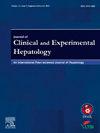FGL-1/LAG-3 轴与酒精相关性肝炎的病程有关:初步报告
IF 3.2
Q2 GASTROENTEROLOGY & HEPATOLOGY
Journal of Clinical and Experimental Hepatology
Pub Date : 2024-10-10
DOI:10.1016/j.jceh.2024.102424
引用次数: 0
摘要
背景酒精相关性肝炎(AH)的短期死亡率高达 40%,这主要与肝细胞再生受损和肝脏炎症失控有关。肝细胞产生的急性期蛋白纤维蛋白原样蛋白 1(FGL-1)通过自分泌信号刺激肝细胞增殖。FGL-1 还是抑制性 T 细胞受体淋巴细胞活化基因 3(LAG-3)的配体。目的我们旨在描述 AH 患者体内 FGL-1 和 LAG-3 的特征,并描述它们与疾病状态和病程的关系。方法32 例 AH 患者在诊断时被纳入,并随访 3 年。我们用 RNA 测序法测定了 FGL-1 和 LAG-3 的肝基因表达,用 ELISA 法测定了血浆中 FGL-1 和可溶性 (s)LAG-3 的表达,用流式细胞术测定了 LAG-3+CD8+ T 细胞的表达。结果确诊为 AH 时,肝脏 FGL-1 mRNA 与 HC 相比有所增加,而血浆 FGL-1 则没有变化。相反,AH 患者肝脏 LAG-3 mRNA 减少。血浆 sLAG-3 水平和 LAG-3+CD8+ T 细胞的频率与 HC 相同。结论我们的数据表明,FGL-1/LAG-3 轴受损可能与 AH 的发病机制和病程有关。本文章由计算机程序翻译,如有差异,请以英文原文为准。
The FGL-1/LAG-3 Axis is Associated With Disease Course in Alcohol-associated Hepatitis: A Preliminary Report
Background
Alcohol-associated hepatitis (AH) has a short-term mortality rate of up to 40% primarily related to impaired hepatocyte regeneration and uncontrolled liver inflammation. The acute phase protein fibrinogen-like protein 1 (FGL-1) produced by hepatocytes stimulates hepatocyte proliferation by autocrine signaling. FGL-1 also is a ligand for the inhibitory T cell receptor lymphocyte activation gene 3 (LAG-3). In these ways, FGL-1 and LAG-3 have beneficial interactions that could be interrupted in AH.
Aims
We aimed to characterize FGL-1 and LAG-3 in patients with AH and describe their relationship with the disease state and course.
Methods
Thirty-two patients with AH were included at diagnosis and followed up for 3 years. We measured the hepatic gene expression of FGL-1 and LAG-3 using RNA sequencing, plasma FGL-1 and soluble (s)LAG-3 using ELISA, and LAG-3+CD8+ T cells using flow cytometry. Healthy persons (HC) and patients with stable alcohol-associated cirrhosis served as controls.
Results
At diagnosis of AH, liver FGL-1 mRNA was increased when compared to HC, whereas plasma FGL-1 was unchanged. In contrast, liver LAG-3 mRNA was reduced in AH. Plasma sLAG-3 levels and the frequency of LAG-3+CD8+ T cells were as in HC. However, those patients who had the lowest plasma FGL-1 and the lowest frequency of LAG-3+CD8+ T cells at diagnosis had the highest disease severity and mortality.
Conclusions
Our data suggest that an impaired FGL-1/LAG-3 axis may be involved in the pathogenesis and course of AH.
求助全文
通过发布文献求助,成功后即可免费获取论文全文。
去求助
来源期刊

Journal of Clinical and Experimental Hepatology
GASTROENTEROLOGY & HEPATOLOGY-
CiteScore
4.90
自引率
16.70%
发文量
537
审稿时长
64 days
 求助内容:
求助内容: 应助结果提醒方式:
应助结果提醒方式:


